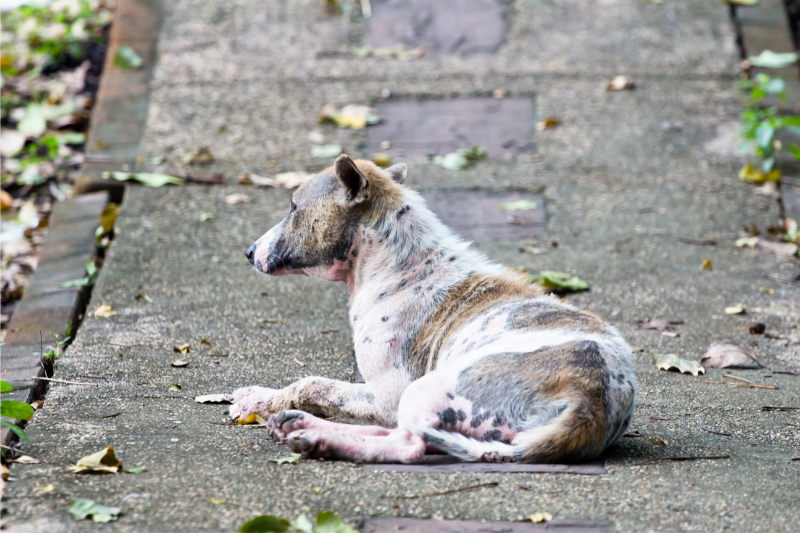Mange in Dogs
Mange is a parasitic skin disease caused by microscopic mites. Two different mange mites cause this skin disease in dogs. One lives just under the surface of the skin (sarcoptic mange) while the other resides in the hair follicles (demodectic mange). Your veterinarian can perform tests to help distinguish between the two types of mange in dogs. Each type has a different cause, treatment, and prognosis.
Demodectic mange is the more common form of the disease and is the result of an overgrowth of the mites Demodex canis, Demodex cornei, or Demodex injai. Demodex mites are natural, permanent residents on all dogs, albeit typically in small numbers. The parasites live within the hair follicles and generally go about their three week life cycle without harming their hosts. A healthy canine immune system tends to keep their population under control.
However, if a dog’s immune system has not fully developed or is compromised (because of sickness, lack of proper nutrition, or side effects of some medications), the mites can quickly proliferate, overrunning the hair follicles and causing hair loss. This means both young and aging dogs can develop a demodectic mange infection if their immune systems are undeveloped or become suppressed. This can also allow for other secondary infections in the skin and hair follicles, such as bacterial or yeast infections.
Demodex is not contagious between other animals or humans. Demodex mites are transmitted to nursing puppies from their mothers during the first few days of life. Subsequently, demodectic mange will usually develop in dogs less than 12 to 18 months of age. As the dog matures, its immune system also matures. Even so, demodectic mange does not develop on most puppies even though they harbor some mites. Puppies are generally immune to the effects of the mites and do not display symptoms of the condition.
On the other hand, if a puppy has a compromised immune system, then hair loss and lesions can appear first on the puppy’s head (because that is the part of the body that is most in contact with the mother during feeding). Mange can later spread to other parts of the body if treatment is not started. Some breeds (such as rottweilers and pit bulls) are also much more predisposed to overgrowth of demodex mites and are more likely to show symptoms of mange.
Sarcoptic mange, otherwise known as scabies, is caused by the parasitic mite Sarcoptes scabiei that burrows just beneath the surface of the skin. This form of mange is not as common as demodex, and it is often found on stray, neglected dogs and on dogs with suppressed immune systems. It is highly contagious and transmissible—via close contact—both to other animals and to humans. Without a host, sarcoptic mites do not survive very long in the environment or on other animals and humans.
Sarcoptic mites live on or just under the surface of the skin. Females burrow deeper into the skin to lay their eggs. Then, after hatching, young mites feed on the skin near the surface. All of this activity causes the skin to itch. If a dog has an allergy to the mites, the itch can become more intense. Sarcoptic mange is one of the itchiest conditions dogs experience, making the pets (and their family) miserable until it is treated. The mites prefer areas of the skin with less fur, so crusty lesions (from scratching) typically appear on the ear flaps or on the abdomen, arm pits, or elbows.
Symptoms of Mange in Dogs
Some symptoms of demodectic and sarcoptic mange (and other ailments) are very similar. So, as mentioned above, a veterinarian can perform tests to determine which type of mange (or other ailment) is affecting your dog so as to administer an effective treatment strategy.
Demodectic mange (demodex) is described as either localized (in a few small patches) or generalized (covering larger portions of the body). Symptoms include hair loss and red scaly skin and dogs with secondary bacterial or yeast skin infections may be itchy but some dogs (puppies in particular) with demodex may or may not itch significantly even with loss of fur. In localized cases, hair loss around the eyes, muzzle, or forelimbs is usually the first sign of mange.
- Hair loss
- Itching
- Red and scaly skin
- Inflammation
- Crusty skin that oozes
- Oily or moist skin
- Skin bumps (pustules)
- Secondary infections (bacterial or yeast)
- Skin that easily bleeds
- Fever
- Appetite loss
- Lethargy
As the disease progresses from localized into the more generalized form, larger areas of hair loss can develop, as well as skin lesions and inflammation. The skin can appear oily or moist, and crusty areas can ooze a clear fluid. Skin may also feel warm, develop bumps (pustules), smell pungent from infection, and bleed easily. In some cases, dogs become sick with fever and develop appetite loss and lethargy.
Sarcoptic mange (scabies) is characterized by moderate to severe itching, skin lesions, and hair loss. The skin becomes red and scaly (on the ears, chest, stomach, armpits, elbows, and ankles), sometimes with yellow crusty areas. Weight loss, appetite loss, lethargy, and depression can also arise in scabies.
- Itching
- Red and rashy skin
- Yellow crusty skin in areas
- Hair loss (alopecia)
- Weight loss
- Appetite loss
- Lethargy
- Depression
- Secondary infections (bacterial or yeast)
- Skin bumps (papules)
- Self-inflicted wounds (excoriations)
- Enlarged or inflamed lymph nodes
Secondary bacterial and yeast infections can occur through the lesions on the skin, and bumps may form—on the chest in particular. Dogs can inflict themselves with deep sores from persistent scratching and biting, which can also become infected. In advanced cases, enlarged or inflamed lymph nodes can also be present.
Diagnosis of Mange in Dogs
Your veterinarian will use similar tests to diagnose either demodectic or sarcoptic mange. These tests can include a combination of:
- Hair samples (for demodex)
- Skin scrapings
- Skin biopsy
- Cytology—to look for other causes of itching/hair loss and to identify secondary infections that may need to be treated.
Since the mites that cause demodex live in the hair follicles, the veterinarian can take hair samples and examine them under a microscope. In this and other microscope exams listed above, the veterinarian will look for a larger-than-usual population of mites. As mentioned previously, all pets naturally carry a small number of mites. If the exam reveals more than a usual number of mites, this is a prompt for a positive diagnosis.
Sometimes, hairs are not enough to detect the presence of mites. Another common test is to take a skin scraping. This must be deep enough to gather hair follicles since these are the domain of demodectic mites. In the case of sarcoptic mites, a skin scraping must reach a depth where the mites burrow to lay their eggs. Again, your veterinarian is looking for more than the typical number of parasites and/or eggs.
Skin biopsies and other tests are usually needed for dogs that have severe symptoms, such as skin infections, or dogs that have not responded to treatment. On the other hand, it is possible that no mites are detected within the samples even though symptoms of mange abound. In that case, other tests or trial treatment may be needed. If your veterinarian makes a positive diagnosis of mange, they will discuss with you treatments that are appropriate for your pet and for the type and severity of the disease.
Your veterinarian may also recommend testing to determine the nature of a pet’s immune deficiency. If your dog’s mange manifested because of a weak immune system, further diagnostics can reveal the cause of immunosuppression so your veterinarian can address this broader issue. The result may be, not just recovery from mange, but better general health for your pup.
Treatment and Prevention of Mange in Dogs
On occasion, dog owners might take it upon themselves to treat their pet at home without the supervision of a veterinarian. This is ill-advised because cases of mange may have underlying, hidden catalysts such as immunodeficiency or current infections. These can cause mange to spread rapidly. Mange can be fatal if pets do not receive correct treatment or if their underlying condition is not managed appropriately.
Both demodectic and sarcoptic mange can have similar treatment strategies. Your veterinarian will devise a plan to eradicate the mite infestation and to heal damaged skin. Treatment can include a combination of oral medication, dips, medicated shampoo, and nutritional support. Antibiotics or antifungal medications may be needed if a secondary infection has set in.
Topical medication. If demodectic mange is in its localized form, a puppy’s developing immune system may sometimes clear up the condition on its own. Or, if the localized condition persists, it is possible that a topical ointment is all that is needed to clear it up. Topical medications work over a period of six to eight weeks to kill the mites. On the other hand, generalized mange is more serious and requires more aggressive treatment to eradicate the disease.
Oral medication. Your veterinarian may recommend oral fluralaner (Bravecto®) as a treatment for demodectic mange. Bravecto® is administered mainly as a preventative for fleas and ticks, but it can also serve as treatment for both demodex and sarcoptic mites. Alternatively, a different medication may be recommended by your veterinarian depending on the pet’s individual case.
Baths and dips. Medicated shampoos can facilitate the softening, exfoliating, and healing of the skin. Your veterinarian may prescribe a shampoo that is the best fit for your dog and his or her condition. Be sure to bathe your pet weekly or as recommended by your veterinarian. Dips contain insecticides that may have serious side effects to both you and your pup. It is best to allow your dog’s veterinarian to administer dips—every two weeks, for two to three months—if your veterinarian deems them necessary.
Diet and supplements. The purpose of nutritional support as part of your pet’s treatment for mange is to boost and support your dog’s immune system. Mites and mange proliferate where immune systems are weak or undeveloped. Your veterinarian may recommend specially-formulated diets and supplements that promote stronger immune response. This is important for puppies, senior dogs, and rescues—all who are at particular risk. Immune support may also be a deterrent to relapses or can aid as a preventative.
Antibiotics and antifungal medications. Sometimes, particularly in cases of generalized demodex, dogs may acquire secondary skin infections in addition to mange. When that is the case for your dog, your veterinarian may recommend antibiotics and/or antifungal medications to help fight the secondary infection. These medications may be needed for up to two months from the start of treatment.
When treating sarcoptic mange in a dog, any other dogs that have come in contact with the infected pet should also receive treatment for scabies. In addition, the pet should be quarantined, and the environment disinfected, including the dog’s bedding, collars, toys, etc. When treating demodectic mange, disinfecting the environment should not be needed.
Bear in mind that a puppy’s immune system takes up to 18 months to mature, and relapses of mange may occur until full maturity. Relapses (whether in puppies or in adult dogs) must be treated the same as at the initial diagnosis, to prevent the mange from spreading uncontrollably. If relapses do occur, these are usually three to six months after treatment has stopped.
In a few instances, a puppy’s immune system may not develop into a strong, resilient agent against disease. Your veterinarian may recommend tests to determine the cause of immunodeficiency and how to bolster your pet’s immunity. During this time, however, your dog’s fight against mange may become a lengthy one. Treatment may require life-long vet care or may have no effect on the mange. But your veterinarian is on your side and will do all they can to help your pet thrive.

